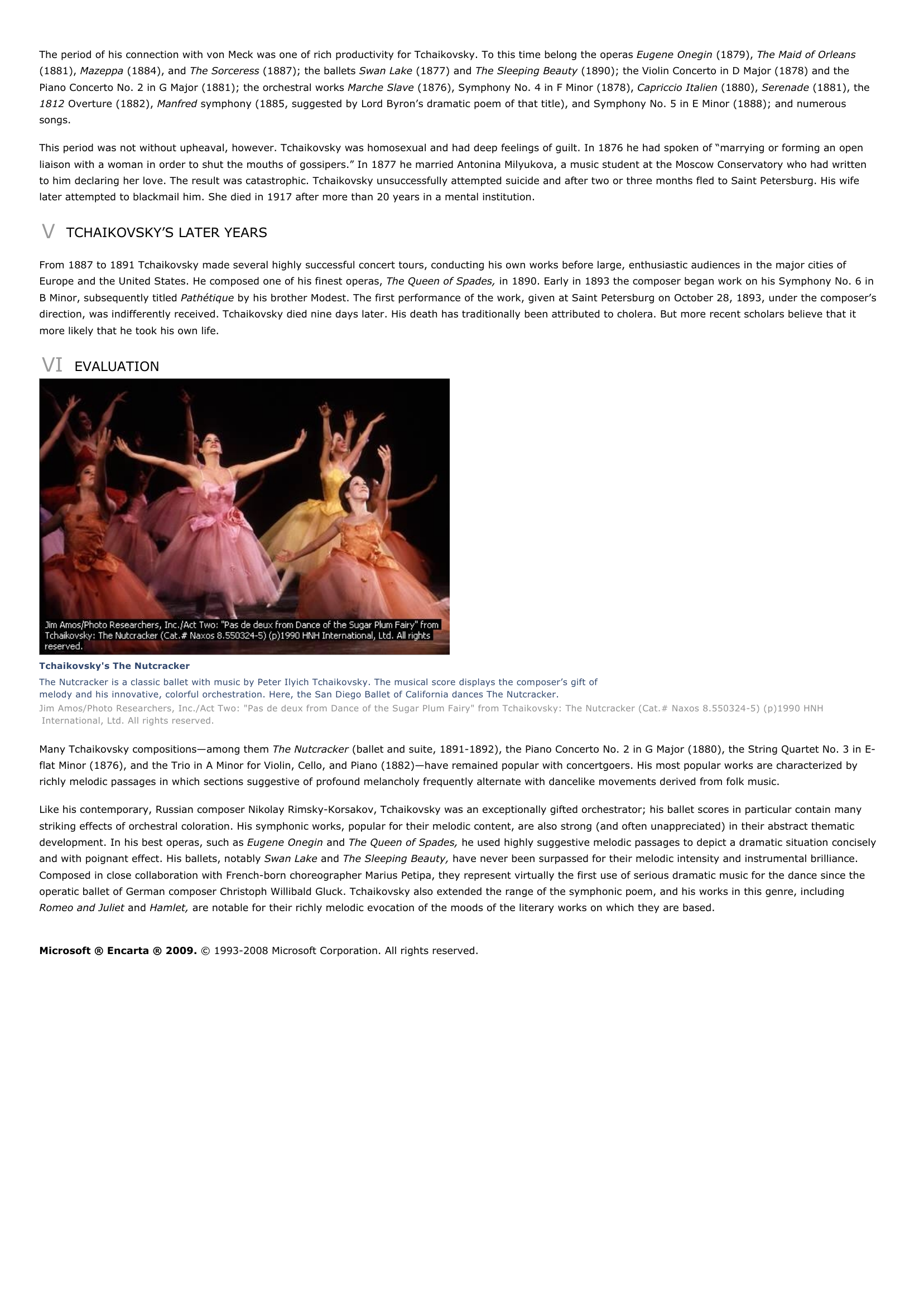Peter Ilyich Tchaikovsky I INTRODUCTION Peter Ilyich Tchaikovsky Peter Ilyich Tchaikovsky's work combined Russian and European influences.
Publié le 12/05/2013
Extrait du document
«
The period of his connection with von Meck was one of rich productivity for Tchaikovsky.
To this time belong the operas Eugene Onegin (1879), The Maid of Orleans (1881), Mazeppa (1884), and The Sorceress (1887); the ballets Swan Lake (1877) and The Sleeping Beauty (1890); the Violin Concerto in D Major (1878) and the Piano Concerto No.
2 in G Major (1881); the orchestral works Marche Slave (1876), Symphony No.
4 in F Minor (1878), Capriccio Italien (1880), Serenade (1881), the 1812 Overture (1882), Manfred symphony (1885, suggested by Lord Byron’s dramatic poem of that title), and Symphony No.
5 in E Minor (1888); and numerous songs.
This period was not without upheaval, however.
Tchaikovsky was homosexual and had deep feelings of guilt.
In 1876 he had spoken of “marrying or forming an openliaison with a woman in order to shut the mouths of gossipers.” In 1877 he married Antonina Milyukova, a music student at the Moscow Conservatory who had writtento him declaring her love.
The result was catastrophic.
Tchaikovsky unsuccessfully attempted suicide and after two or three months fled to Saint Petersburg.
His wifelater attempted to blackmail him.
She died in 1917 after more than 20 years in a mental institution.
V TCHAIKOVSKY’S LATER YEARS
From 1887 to 1891 Tchaikovsky made several highly successful concert tours, conducting his own works before large, enthusiastic audiences in the major cities ofEurope and the United States.
He composed one of his finest operas, The Queen of Spades, in 1890.
Early in 1893 the composer began work on his Symphony No.
6 in B Minor, subsequently titled Pathétique by his brother Modest.
The first performance of the work, given at Saint Petersburg on October 28, 1893, under the composer’s direction, was indifferently received.
Tchaikovsky died nine days later.
His death has traditionally been attributed to cholera.
But more recent scholars believe that itmore likely that he took his own life.
VI EVALUATION
Tchaikovsky's The NutcrackerThe Nutcracker is a classic ballet with music by Peter Ilyich Tchaikovsky.
The musical score displays the composer’s gift ofmelody and his innovative, colorful orchestration.
Here, the San Diego Ballet of California dances The Nutcracker.Jim Amos/Photo Researchers, Inc./Act Two: "Pas de deux from Dance of the Sugar Plum Fairy" from Tchaikovsky: The Nutcracker (Cat.# Naxos 8.550324-5) (p)1990 HNHInternational, Ltd.
All rights reserved.
Many Tchaikovsky compositions—among them The Nutcracker (ballet and suite, 1891-1892), the Piano Concerto No.
2 in G Major (1880), the String Quartet No.
3 in E- flat Minor (1876), and the Trio in A Minor for Violin, Cello, and Piano (1882)—have remained popular with concertgoers.
His most popular works are characterized byrichly melodic passages in which sections suggestive of profound melancholy frequently alternate with dancelike movements derived from folk music.
Like his contemporary, Russian composer Nikolay Rimsky-Korsakov, Tchaikovsky was an exceptionally gifted orchestrator; his ballet scores in particular contain manystriking effects of orchestral coloration.
His symphonic works, popular for their melodic content, are also strong (and often unappreciated) in their abstract thematicdevelopment.
In his best operas, such as Eugene Onegin and The Queen of Spades, he used highly suggestive melodic passages to depict a dramatic situation concisely and with poignant effect.
His ballets, notably Swan Lake and The Sleeping Beauty, have never been surpassed for their melodic intensity and instrumental brilliance. Composed in close collaboration with French-born choreographer Marius Petipa, they represent virtually the first use of serious dramatic music for the dance since theoperatic ballet of German composer Christoph Willibald Gluck.
Tchaikovsky also extended the range of the symphonic poem, and his works in this genre, includingRomeo and Juliet and Hamlet, are notable for their richly melodic evocation of the moods of the literary works on which they are based.
Microsoft ® Encarta ® 2009. © 1993-2008 Microsoft Corporation.
All rights reserved..
»
↓↓↓ APERÇU DU DOCUMENT ↓↓↓
Liens utiles
- Ballet I INTRODUCTION Tchaikovsky's The Nutcracker The Nutcracker is a classic ballet with music by Peter Ilyich Tchaikovsky.
- Joseph Staline par Roger Pethybridge Centre of Russian and East European Studies, University College of Swansea De l'avis de maint biographe, il est impossible de relater la vie privée de Staline.
- Nikita Khrouchtchev par Roger Pethybridge Centre of Russian and East European Studies,
- Léonide Illitch Brejnev par Roger Pethybridge Centre of Russian and East European
- Michelangelo I INTRODUCTION Michelangelo (1475-1564), Italian painter, sculptor, architect, and poet whose artistic accomplishments exerted a tremendous influence on his contemporaries and on subsequent European art.








